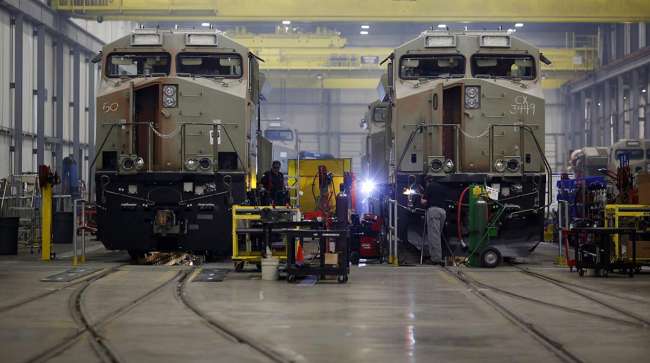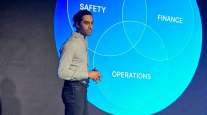Bloomberg News
AI Startup Helps Diesel Trains Clean Up Their Emissions

[Stay on top of transportation news: Get TTNews in your inbox.]
Transportation is responsible for one quarter of the world’s greenhouse gas emissions. While companies have touted electric vehicles and sustainable aviation fuel as ways to cut emissions from air and road travel, reducing the climate impact of rail transport has received relatively little attention.
A Canadian startup wants to lessen that impact. Montreal-based RailVision Analytics has developed artificial intelligence-enabled software to help locomotive engineers make small adjustments in train driving that could lead to big savings in diesel fuel. That could help freight and passenger trains cut into the roughly 100 million tons of planet-warming gases released into the atmosphere every year.
“It is just like Google Maps,” says Dev Jain, founder of RailVision Analytics, of his AI application that can be downloaded on a tablet and run offline. While Google Maps tells automobile drivers to turn right or left, RailVision’s app guides locomotive engineers to “stay idle” in the next mile or “increase speed.”
Essentially, the idea is to enable locomotive engineers to eliminate wasteful practices and leverage invisible forces that could assist their driving. The law of inertia discovered by Isaac Newton in 1686 states a moving object can continue in the same direction unless a force affects it. That means a vehicle can stay in motion — in other words, coast — without the use of manmade propulsion until friction or other forces stop it.
But “driving a train is like driving a roller coaster,” Jain says. The length of trains means that when trains are traveling on tracks where the elevation changes, often, some railcars will begin climbing uphill while the rest are still going downhill. That poses a tough question for locomotive engineers: Should they coast or pull the throttle for more horsepower?
To solve those puzzles, RailVision collects data from rail operations to simulate train dynamics and uses an algorithm to determine the most fuel-efficient driving pattern. While the AI solution is still in its infancy, Jain says it has helped Metrolinx, a government agency that serves millions of riders in the province of Ontario, save more than 1.5 million liters of diesel fuel during a one-year experiment. RailVision also counts Via Rail Canada Inc., the country’s main intercity passenger train operator, as an early adopter.
Trains are arguably the most climate-friendly way of getting around. According to the International Energy Agency, rail travel releases 22 grams of carbon dioxide on average per passenger-kilometer globally, which is dwarfed by 123 grams generated by air travel, and the 145 grams per passenger-kilometer from journeys in cars.
Diesel, though, is a particularly dirty fuel. Unlike Europe and Asia, where electrification has made headways in passenger rail service, most longhaul trains in the U.S. and Canada rely on diesel fuel — a status that is unlikely to change anytime soon, according to Bruno Idini, a transport analyst with the IEA.
✨That moment when you see your app mounted in-cab on a major #rail route.✨ We love getting boots on the ground and working closely with the engineers who use our app. A few weeks ago we got to see #EcoRail in action in Montréal. pic.twitter.com/E0rChhFzKX — RailVision Analytics (@RVAnalytics) July 5, 2023
That’s because running trains on electricity requires a costly infrastructure upgrade, and the region’s relatively sparse passenger service can’t justify that investment, Idini says. It’s also expensive to build electric rail networks for freight trains to bring goods to cities and towns scattered across vast distances. Although some railway companies have begun replacing diesel with lower-emission biofuel, that replacement remains “a drop in the bucket,” he adds, citing its high price and limited supply alongside other constraints. AI could offer a relatively affordable alternative to cutting rail’s carbon footprint.
“It was the first time that we have seen an innovation that was easily installed and applicable to our reality,” says Francoise Granda Desjardins, a senior adviser of sustainability at Via Rail, which has been testing RailVision’s AI solution since 2021.
Via Rail started its experiment with a simulation trial, during which engineers sat in a replica of a locomotive control cab to drive trains in virtual reality. After six months, the engineers used 15% less diesel following AI-generated guidance than driving without it.
The company has since tested the technology on passenger trains running between Toronto and Ottawa. While Via Rail has yet to finalize the findings, “it has been a positive experience so far,” Desjardins says.
Founded in 2019, RailVision raised $4 million in a seed round last year from investors including Trucks Venture Capital and Blackhorn Ventures. Since fuel is the second-largest operating expense after labor costs for North America railroads, the startup’s solution is turning heads. Genesee and Wyoming Inc., a multinational railroad operator whose business includes freight trains in Canada, has recently rolled out a pilot with RailVision for its cargo service between Montreal and Quebec City.
RailVision charges railway companies a subscription fee for its AI guidance. While Jain declined to disclose the pricing, he says the service “usually pays for itself in a few months” in saved fuel costs.
There could be notable climate gains, too. Take Via Rail. If the AI solution were deployed in all of its trains, the anticipated 15% of fuel saving would translate to an annual reduction of over 20,000 tons of carbon emissions, the company estimates. That is equivalent to taking more than 4,000 cars off the road each year.
Want more news? Listen to today's daily briefing above or go here for more info
Still, some wrinkles have to be ironed out in order to tap that potential. Since it is more complicated to drive in the real world than in a controlled environment, there is a gap in performance between simulated and actual train operations, according to Desjardins. Additionally, saving fuel will only happen if humans take the AI advice. As safety regulations prevent locomotive engineers from looking at the app or listening to audio alerts while the train is in motion, they are asked to memorize all the instructions prior to the departure. It remains to be seen whether locomotive engineers would be willing to improve fuel efficiency in their everyday work or put their full trust in AI in the first place.
To reach net-zero emissions, rail transport ultimately will have to switch away from fossil fuels. But until that happens, “technologies like the one from RailVision are really helpful,” Desjardins says. “If we go into up to 15% fuel reduction, that is significant.”



